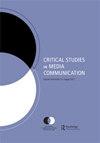我要再一次破坏它:《拉尔夫打破互联网》中“健康”和“有毒”男子气概的错误二分法
IF 1.5
2区 文学
Q3 COMMUNICATION
引用次数: 1
摘要
本文考察了迪士尼动画电影《拉尔夫破网》(2018)中男性气质的表现。大众对这部电影的评论主要集中在对有毒男子气概的批评上。有毒男子气概的概念通常与同性恋恐惧症和厌女言论联系在一起,最终通过将“有毒”的男性行为描绘成可以“治愈”或“修复”的东西,从而加强和拯救了霸权男子气概的元素。为了探究在动画媒体中看到的有毒男子气概的困扰概念,本文展示了拉尔夫打破互联网如何将健康和有毒男子气概的错误二分法具体化。本文通过考察拉尔夫的外表、他的行为、他与女性的操纵关系以及电影的最终解决方式反映了当前的男子气概危机,认为虽然影评人声称电影批评了有毒的男子气概,但电影本身实际上重新定义了霸权男子气概的品质。通过在学术研究和评论中引用有毒的男性气质,评论家们掩盖了对男性气质电影可能提出的积极和消极的其他批评。本文章由计算机程序翻译,如有差异,请以英文原文为准。
I’m gonna wreck it, again: the false dichotomy of “healthy” and “toxic” masculinity in Ralph Breaks the Internet
ABSTRACT This article examines the representation of masculinity in the animated Disney film Ralph Breaks the Internet (2018). Popular reviews of the film focused heavily on critiques of toxic masculinity. Often associated with homophobic and misogynistic speech, the concept of toxic masculinity ultimately serves to reinforce and rescue elements of hegemonic masculinity by painting “toxic” male behaviors as something that can be “cured” or “fixed.” To probe the troubled concept of toxic masculinity as seen in animated media, this article demonstrates how Ralph Breaks the Internet reifies a false dichotomy of healthy and toxic masculinity. Through examining the ways Ralph’s physical appearance, his behaviors, his manipulative relationships with women, and the film’s ultimate resolution reflect the current crisis of masculinity, this article argues that while reviews claim the film critiques toxic masculinity, the film itself actually reinscribes qualities of hegemonic masculinity. By invoking toxic masculinity in scholarship and reviews, critics obscure other critiques of masculinity films may put forward—positive and negative.
求助全文
通过发布文献求助,成功后即可免费获取论文全文。
去求助
来源期刊

Critical Studies in Media Communication
COMMUNICATION-
CiteScore
2.10
自引率
0.00%
发文量
34
期刊介绍:
Critical Studies in Media Communication (CSMC) is a peer-reviewed publication of the National Communication Association. CSMC publishes original scholarship in mediated and mass communication from a cultural studies and/or critical perspective. It particularly welcomes submissions that enrich debates among various critical traditions, methodological and analytical approaches, and theoretical standpoints. CSMC takes an inclusive view of media and welcomes scholarship on topics such as • media audiences • representations • institutions • digital technologies • social media • gaming • professional practices and ethics • production studies • media history • political economy. CSMC publishes scholarship about media audiences, representations, institutions, technologies, and professional practices. It includes work in history, political economy, critical philosophy, race and feminist theorizing, rhetorical and media criticism, and literary theory. It takes an inclusive view of media, including newspapers, magazines and other forms of print, cable, radio, television, film, and new media technologies such as the Internet.
 求助内容:
求助内容: 应助结果提醒方式:
应助结果提醒方式:


